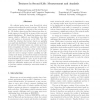Free Online Productivity Tools
i2Speak
i2Symbol
i2OCR
iTex2Img
iWeb2Print
iWeb2Shot
i2Type
iPdf2Split
iPdf2Merge
i2Bopomofo
i2Arabic
i2Style
i2Image
i2PDF
iLatex2Rtf
Sci2ools
104
click to vote
ICPADS
2008
IEEE
2008
IEEE
Textures in Second Life: Measurement and Analysis
We collected packet traces from Second Life client sessions and analyzed the packet contents. We observed that textures constitute a majority of the network traffic. We further characterized the textures from three selected regions in Second Life in terms of their size and spatial distributions. We found that textures in these regions exhibit a different size distribution from files on a file system or documents on the Web. We also verified the intuition that texture objects are spatially non-uniformly distributed. Surprisingly, we found that the selected Second Life regions can contain up to hundreds of megabytes of textures, and there exist locations in these regions that encompass a large portion of these textures within their area-of-interest. Our work motivates the need to manage textures carefully and efficiently in the design of networked virtual environments such as Second Life, and hints at the amount of storage and bandwidth required at a peer if peer-to-peer techniques...
Related Content
| Added | 30 May 2010 |
| Updated | 30 May 2010 |
| Type | Conference |
| Year | 2008 |
| Where | ICPADS |
| Authors | Huiguang Liang, Mehul Motani, Wei Tsang Ooi |
Comments (0)

